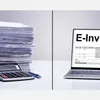Explainer: Know everything about B2B and B2C e-invoicing
E-invoicing, under the Goods and Services Tax (GST) law, involves businesses reporting details of specified GST documents to a government-notified portal to obtain a unique reference number.
Indian businesses are growing at an increased pace, which has necessitated the digitalisation of business processes and finance for every company, big or small. Today, more and more Indian companies are moving from paper to digital invoices.
Electronic invoicing or e-invoicing, under the Goods and Services Tax (GST) law, involves businesses reporting details of specified GST documents to a government-notified portal to obtain a unique reference number.
Invoice registration portals (IRPs) such as NIC and Clear are pre-approved web portals for reporting specific tax invoice details for verification and receiving unique invoice reference numbers (IRN) and signed QR codes.
Purpose of e-Invoicing
Electronic invoicing enables businesses to embrace the digitalisation of the invoice-to-pay process. GSTR-1 return filed to report the periodic sales information auto-populates with the e-invoice details as and when the GST Network approves them.
In turn, the government aims to boost revenue by curbing fraudulent transactions and tax evasion through the authentication of business-to-business (B2B) invoices and export invoices.
ALSO READ

Applicability to B2B and roadmap
Specified businesses are required to implement this system in phases. The fourth phase began on April 1, 2022, where businesses with over Rs 20 crore annual turnover in any financial year between 2017-18 and 2021-22 must generate e-invoices.
The government has notified the next phase to apply from October 1, 2022, extending it to businesses with a cumulative turnover of more than Rs 10 crore. The turnover shall be computed by aggregating all GSTINs registered under a single PAN in India.
The system applies to GST invoices, debit notes, and credit notes raised for taxable B2B, business-to-government (B2G) transactions, and exports, including supplies made under the reverse charge mechanism and sales on ecommerce platforms.
However, the e-invoicing system does not apply to exempted supplies, business-to-consumer (B2C) transactions, job works, and imports. In other words, it excludes documents such as the delivery challans and bill of supplies.
The system also excludes banking, insurance, NBFC, goods transport or passenger transport business, multiplex cinemas, SEZ units, government departments, and local authorities, who don’t need to generate e-invoices even if they meet the above turnover criteria.
The government plans to cover businesses with a turnover of over Rs 5 crore under this system from January 1, 2023.
Dynamic QR code for B2C
e-Invoicing does not apply to B2C transactions. For instance, if the business sells only to consumers not registered under GST by issuing a bill of supply, it need not report the bill to the GST Network for authentication.
Reporting is not required as the end user will not be claiming input tax credit (ITC), unlike B2B transactions.
The government introduced a rule for large enterprises, making B2C sales to ensure transparency in reporting their earnings. From December 1, 2020, businesses with an annual turnover of over Rs 500 crore in any preceding financial year from 2017-18 need to generate dynamic QR codes on their B2C invoices.
However, the government waived the penalty for non-compliance up to September 30, 2021.
The dynamic QR code will contain details of the GSTIN of the supplier, bank account details of the payee, basic invoice details, and a digital payment link.
A dynamic QR code is not needed when payment is made before the invoice is issued. But a cross-reference must be provided on the invoice against which payment was received through cash, electronic mode, or both.
Suppose an applicable enterprise sells to both GST-registered buyers and unregistered customers. It must comply with e-invoicing for only the B2B transactions.
Consequences of not complying
Any failure to comply with the e-invoicing or the dynamic QR code rules, respectively, while raising B2B and B2C invoices, attracts a penalty of Rs 25,000 per non-compliant invoice.
The penalty for not issuing any invoice is higher of two amounts—100% of the tax dues or Rs 10,000.
Edited by Suman Singh
(Disclaimer: The views and opinions expressed in this article are those of the author and do not necessarily reflect the views of YourStory.)







